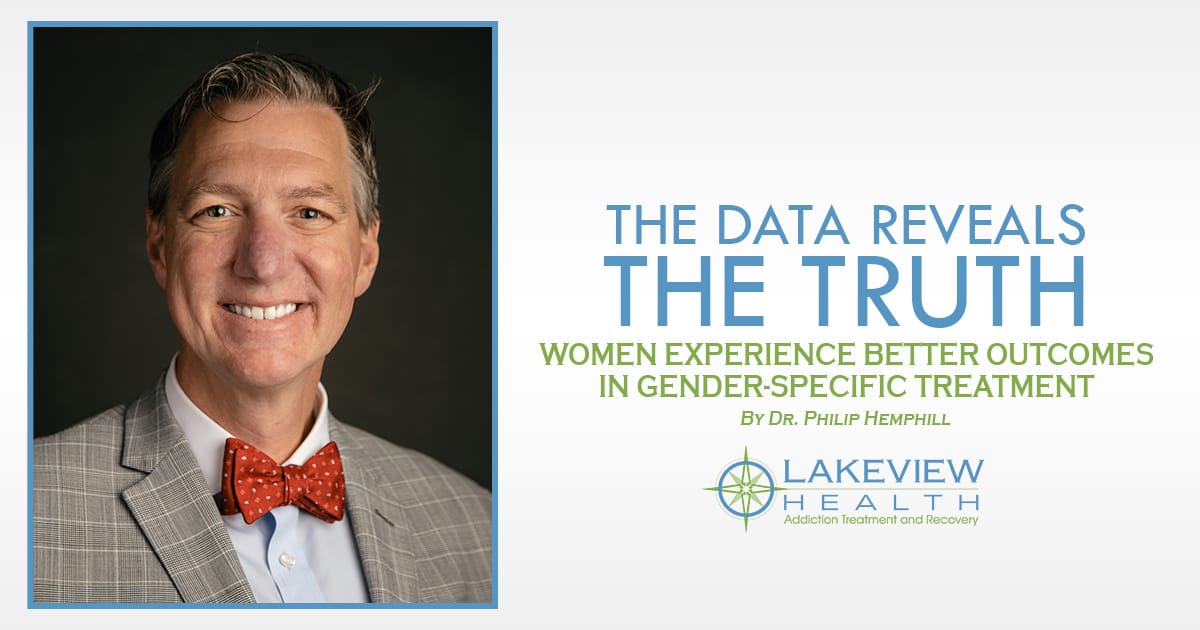

By: Philip Hemphill
The Data Reveals the Truth: Women Experience Better Outcomes in Gender-Specific Treatment
The vision, intuition, and data gathered by Lakeview Health leaders and staff that lead to the completion of our gender-specific state-of-the-art facility, program, and dedicated staff has served hundreds of women in need of Substance Use Treatment during the past year. Today, our data reveals that this treatment experience has enhanced their outcomes in all areas. We compared the amount of positive change pre- and post-treatment of our female patients for one year (04/2015-04/2016) before opening our gender responsive treatment program to the females who experienced treatment after we opened the program (05/2016-05/2017). Results showed improvement of the following subscales:
- Depression
- Panic/Anxiety
- Quality of Life
- Self-Confidence
- Sleep
- Social Functioning
- Work Functioning
- Substance Abuse
Treatment Outcome Package (TOP)
This data comes from our Treatment Outcome Package (TOP) which is a scientifically validated client assessment tool that has been used successfully by millions of people in 36 states. TOP provides an efficient way for patients to share their full story. Because it is a self-reporting questionnaire, patients feel that it gives them a powerful voice during and after treatment. This instrument documents the effectiveness of treatment. It not only measures improvement in various health domains (Substance Abuse, Depression, Mania, Panic/Anxiety, Psychosis, Quality of Life, Sexual Functioning, Sleep, Social Functioning, Suicidality, Violence and Work Functioning), but it also shows the severity of problems and the strengths on which to build. We are excited to share these results as evidence that women are responding better to gender-specific treatment. This data validates past research and is a ‘call to action’ as a means of improving treatment outcomes. Here’s what we’ve learned from past data:
- Women are less likely than men to access treatment over a lifetime.
- Women advance more rapidly from use to regular use to first treatment.
- Women with SUD are more vulnerable to adverse medical conditions.
- Barriers to treatment are ethnicity, employment, pregnancy, fear of losing custody of children, fear of prosecution, and economic status.
- Women required different approaches to treatment which can affect retention and should include treating mood disorders, eating issues, anxiety, and post-traumatic stress.
- Addressing sexual and physical assault in mixed-gender treatment programs is less desirable for women.
- Women are less likely to have family or partner support and greater stigma and discrimination.
- Women may be perceived as having less of a need to receive treatment.
- Women’s need for treatment usually come from an internal or subjective stress as opposed to external pressures.
- Women in non-hospital residential facilities or facilities providing combined mental health and substance abuse treatment services are more likely to complete planned treatment than women receiving treatment at non-methadone outpatient facilities.
- The Women, Co-occurring Disorders, and Violence Study (WCDVS), a multisite cooperatives study, gives some evidence that comprehensive integrated services may provide more effective treatment for women with co-occurring substance and psychiatric disorders and histories of victimization.
- Some evidence suggests that female clients matched with gender-congruent counselors may have better abstinence outcomes.
- Women in women-only treatment programs averaged significantly more days in treatment and were more likely to complete treatment than women in mixed-gender programs.
- Clients in women-only programs experience less exposure to sexual harassment and find the atmosphere to be more conducive to the open expression of women’s needs and experiences.
- Women-only treatment may be an important factor for a subgroup of women who might otherwise not have access to care or participate freely.
- Women are able to focus on more psychosocial issues.
- Women’s treatment needs have progressively improved over the past 25 years.
Stay connected with us as we continue to present our findings because we strive to be transparent and make adjustments to our care model to maximize our therapeutic impact on all patients.





